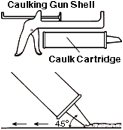October is a great month to weatherproof for the upcoming stormy season. You can save energy and keep your home toasty and warm by sealing all cracks with caulk to prevent cold drafts and water intrusion.
Because all building materials expand and contract, to do its job properly, caulk must:
• stick firmly to the materials on either side of the crack,
• stretch and recover its original shape when the materials expand and contract, and
• remain flexible as the materials age.
Here are some considerations when choosing caulk:
• consider first the type of material(s) you want the caulk to adhere to;
• if there will be residual moisture on the surface materials during application;
• if the caulked joint will be subject to moisture, water or weather, and mildew growth;
• what temperatures the caulk needs to withstand and whether they will fluctuate frequently; and
• if the caulked joint will later be painted.
Here are some different types of caulk and their best uses:
Silicone caulk is excellent for smooth, nonporous surfaces, such as metal, glass, glazed tile, and plastics. It sticks, flexes, does not shrink, adheres where there is residual moisture, stands up well to water exposure, and lasts a long time. Although pure silicone cannot be painted, it is available in pigmented form. Clean up silicone caulk immediately with mineral spirits. Best for: filling gaps around metal windows and doors.
Acrylic latex caulk is a general-purpose sealant, adhering best to porous materials like wood and concrete, even under wet conditions. It is flexible and durable and shrinks when it cures. Acrylic latex caulk can be painted, but is also available in pigmented form. If mildew growth is a problem, use this caulk with added mildewcide. Clean up with soap and water. Best for: filling small gaps in doorframes and window frames.
Siliconized acrylic latex caulk is an all-purpose caulk. It is good for both interior and exterior applications and is long-lasting. This type of caulk lacks some of the adhering qualities of both the 100 percent silicone and high-quality acrylic latex caulk but adheres reasonably well to both porous and nonporous surfaces, including those with residual moisture. Like acrylic latex caulk, siliconized acrylic latex caulk can be painted, is also available in pigmented form, and cleans up with soap and water. Best for: wood siding, cracks in brick and stone, weatherproofing; ideal for both indoor and outdoor projects.
Applying caulk
A caulking gun is easy to use and will make using caulk a lot easier. Most caulk tubes are a standard size to fit any caulking gun.
1. Make sure the area to be caulked is dry and free of old, dried caulk. A putty knife and wire brush can be helpful in preparation. The caulk should not be allowed to stick to the material at the back of the crack (otherwise it won’t flex as the gap changes). If the crack is deep, fill it first with foam or fiberglass.
2. Insert the caulk cartridge into the caulking gun shell. Cut the cartridge’s plastic nozzle at a 45° angle, so the width of the nozzle will span the crack you will be caulking. Poke the pointed end of a large nail into the cartridge nozzle, breaking the seal.
3. To operate the caulking gun, turn the plunger in back of the tube to engage the trigger mechanism. As you pull the trigger, the caulk is squeezed out of the nozzle and into the crack. Hold the caulking gun at a 45° angle, pull the trigger and, at the same time, pull the gun down the crack in a steady, slow motion. The right speed is crucial: move too slowly, and the caulk will bulge out of the crack; move too quickly, and you will underfill the crack.
4. When you have finished running a bead of caulk, immediately turn the plunger at the back of the caulking gun. This releases the pressure so caulk doesn't continue to ooze out of the nozzle.
5. Clean up stray caulk as soon as you finish running the caulking lines. If there is caulk left in the cartridge when you finish the job, stick a large nail or golf tee in the nozzle to keep the caulk fresh for your next project.
Julia Strzesieski is the marketing coordinator at Cole Hardware and can be reached at julia@northsidesf.com.








